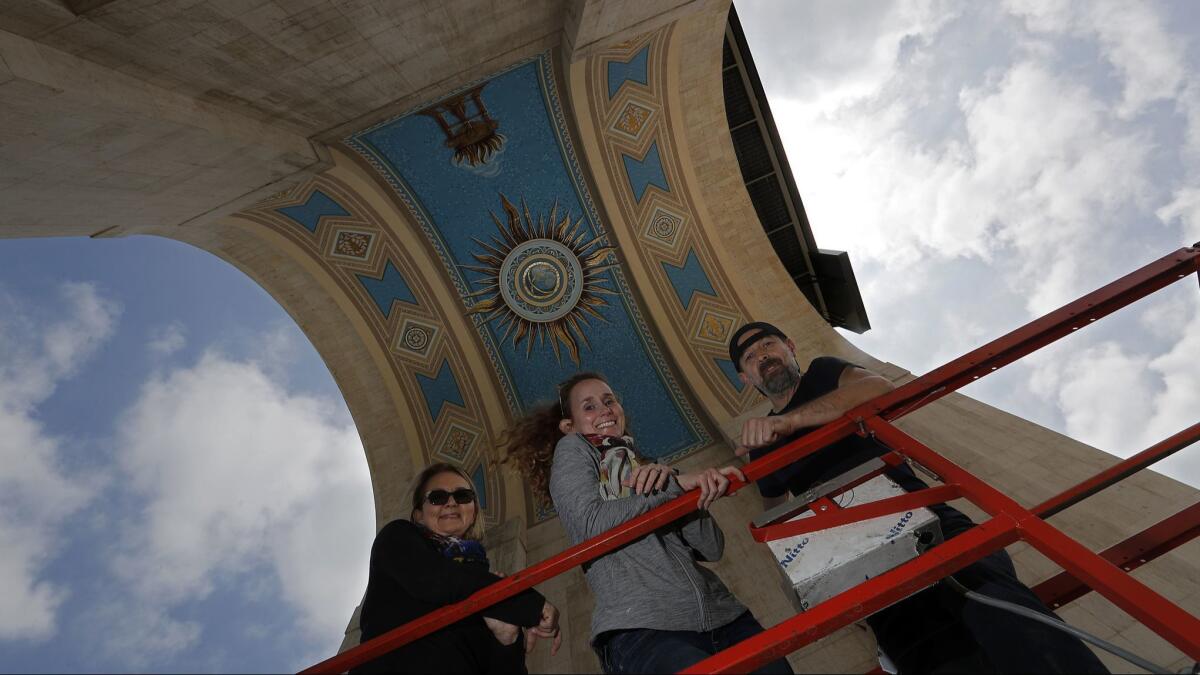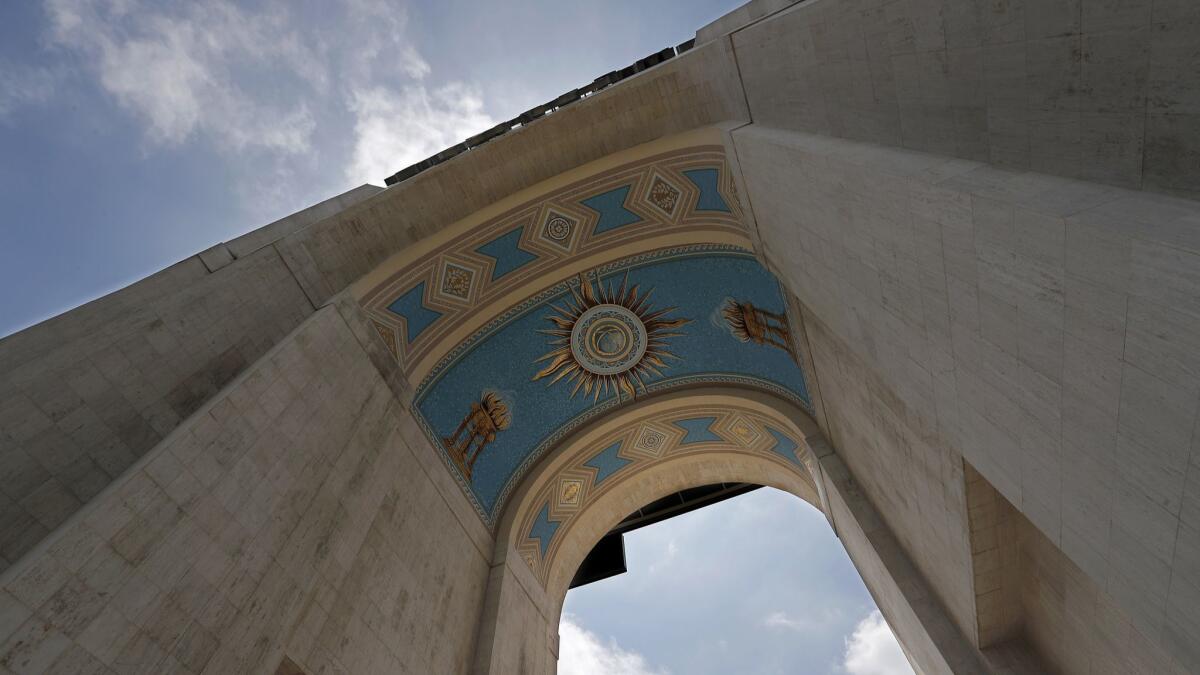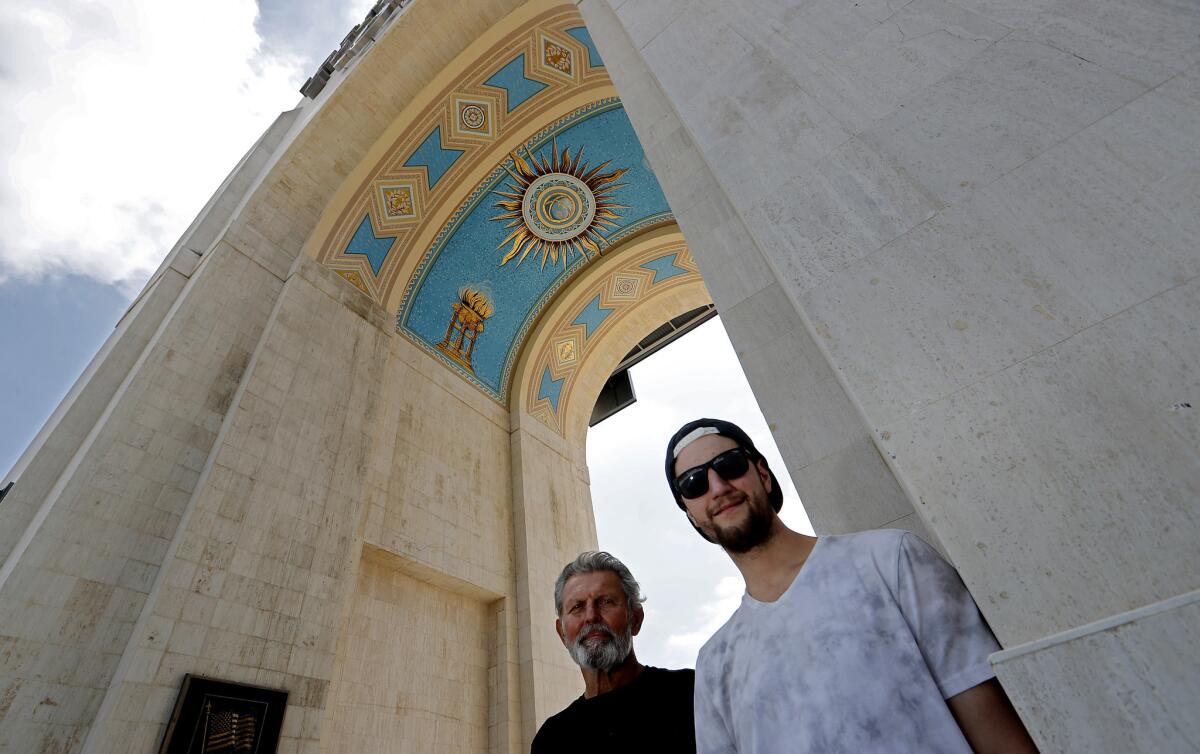Must Reads: It was the Coliseum’s mystery mural, until a teenage detective solved its 50-year puzzle

- Share via
For decades, the curving mural depicting a golden sun has greeted visitors to the Los Angeles Memorial Coliseum.
Faded by the elements, its once-vibrant blue lost some luster over the years. The gold-leaf paint had chipped away. Still, the image drew eyes upward.
No one seemed to know who had painted the scene adorning the Coliseum’s main archway — or when. Guides referred to it as a “mystery mural,” the story of its origins as shrouded by time as the artwork itself.
But after taking a tour of the historic stadium a few years ago, one local teenager became engrossed with its history.

Dean Gordon estimates he’s been to the Coliseum more than 100 times. But before that day, he’d never given much thought to the mural high above the peristyle entrance. Two golden Olympic torches flanking a flaming sun, its center a depiction of the planet Earth and the 12 signs of the Zodiac.
Solving its mystery soon became his mission.
Two summers ago, at age 17, Gordon began his quest — poring through library books and searching archives, hoping to find a clue that would lead him to the artist.
“I basically contacted every single person who might have an idea,” he said, “every archivist, historian or professor who might have some connection to the mural,” rumored to have been painted before the Coliseum hosted the 1932 Olympics.
After a series of dead ends, Gordon found a clue in the form of a Los Angeles Central Library notecard that read “H. Rosien Coliseum.”
Further online digging produced nothing — until he came across a single tweet:
“Please don’t touch the mural inside the arch that my FIL Heinz Rosien painted prior to the Olympics!!”
The plea, posted in 2016, was from Mary Lou Rosien in response to the Coliseum’s announcement that parts of the stadium were being overhauled. The mural would be part of renovations, which eventually totaled $315 million, by USC. The university operates and manages the Coliseum.
Years before, during a broadcast of a Trojans football game, the camera had panned under the Coliseum’s archway and focused on the mural.
Watching from his home in upstate New York, Rosien’s husband, Igor, was flooded with emotion.
He and his father, Heinz Rosien, had worked on the mural together.
The Los Angeles Coliseum Commission tasked the elder Rosien with the job in 1969, in hopes of helping the city win a bid for the 1976 Olympics. Heinz Rosien, a German immigrant, was a well-known artist in Alhambra and had painted works at various schools, banks and theaters — including the Ahmanson in downtown L.A.’s Music Center.
The archway of the Coliseum proved to be a precarious canvas.
The underside of the curved portico stood more than 70 feet off the ground. To reach it, father and son scaled scaffolding without the aid of safety belts, which now are commonplace. They painted upside down.
“People talk about Michelangelo and the Sistine Chapel,” Igor Rosien said. “My dad was up there battling the elements.”
A teenager at the time, Igor spent the summer, fall and winter of 1969 working on the mural with his father. At the end of their workdays, the two would return home looking like statuettes, their hair and faces covered in gold paint.
Not long after the mural was completed, Rosien entered USC as a student. On occasion, he said, he would visit the stadium and be filled with pride as onlookers gazed up at the work he produced with his dad.
L.A. didn’t end up winning the Olympics bid in the ’70s. But a few years later, at the opening day of the 1984 Summer Games, Rosien beamed as people took pictures of his father’s work inside the Coliseum.
“I wanted to say, ‘That’s my dad’s. He did that.’ ”
By then, Rosien had moved across the country. His father died on Jan. 1, 2007, at age 86.
The origins of the mural were all but lost — until Gordon started his detective work.
The teen tracked Rosien shortly after spotting his wife’s tweet, shocked to learn that someone directly connected with the artwork was still alive.
“The entire time I was trying to figure out who painted it, I thought it was from 1932,” said Gordon, now 19 and a student at Amherst College in Massachusetts. “All my research was in that time period.”
Not that there was a wealth of material for him to work with. A search through the Los Angeles Times archives revealed only one reference to the mural’s painter: a 1982 letter to the editor from the man himself.
In reference to a photo published two years before the 1984 Olympics, Heinz Rosien identified himself as the creator:
“In the article ‘Olympics — An Ongoing Legacy,’ you featured two murals, one painted by students at Central Adult High School. The other described as a delicate painting on the ceiling was painted by me. Heinz L. Rosien.”
The end of Gordon’s search two years ago led to a series of hours-long discussions about the mural — and the start of a friendship between the younger Rosien and the student detective.
“Thankfully, Dean didn’t take ‘mystery mural’ as an answer,” Igor Rosien said.
When it came time this spring to restore the mural, Gordon’s discovery and resulting report on the mural proved helpful.
Over the course of their work, which was recently completed, the artists reached out to Rosien, asking about the paints and techniques his father had used. A photo of the senior Rosien working on the design of the mural provided insight as well.
Aneta Zebala, Suzanne Morris and Adam Romcio have been in the conservation business for decades, restoring artwork at Griffith Observatory and the Wilshire Temple, under bridges and in libraries around Los Angeles.
But the Coliseum’s mural has been one of their most challenging projects, they said.
It had been damaged by water and, after decades of being battered by the elements (including the wind that races through the archway), the design had nearly disappeared. The lack of historical reference also was not ideal.
“We’re used to having all the information — or a lot of it,” Morris said.
“We’re well-trained conservators,” Zebala added, “so we don’t make up stuff. We go by what’s there to offer original intent to the design.”
Before the mural’s restoration got underway, Gordon and Rosien met outside the Coliseum. There, the artist presented the young detective with one of his dad’s paintings.

And on a sunny day in June, Nick Rosien — Igor’s son and Heinz’s grandson — was in town to visit his Uncle Mick. Because the youngest Rosien had never seen the mural, his father suggested they add a trip to the Coliseum to their itinerary.
The scaffolding had just come down from the archway. The tarps were cleared, and the revitalized artwork was ready. The Rosiens were the first to see the mural’s unofficial debut.
Fifty years after it was painted, the vibrant blue and gold had returned. And on either side of the archway, the glittering signature of Heinz Rosien dared anyone to forget him again.
More to Read
Sign up for Essential California
The most important California stories and recommendations in your inbox every morning.
You may occasionally receive promotional content from the Los Angeles Times.











